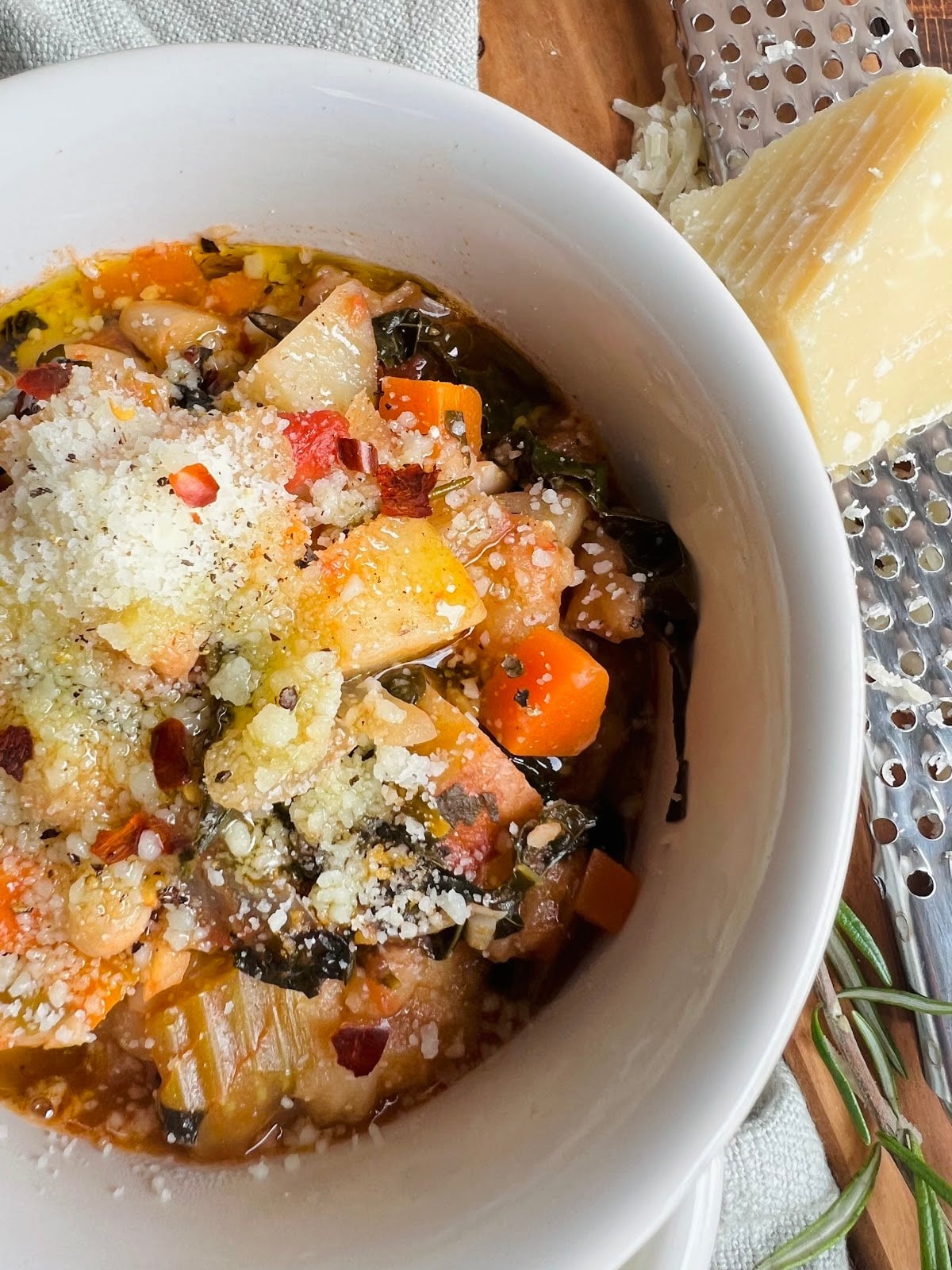
This post may contain affiliate links or sponsored content. That means if you click on my link and buy something, I will earn a small commission from the advertiser at no additional cost to you. For more information on this, please click here.
Authentic Tuscan Ribollita Soup is a hearty, rustic soup abundant with nutritious vegetables and beans and thickened with day-old bread. Hailing from the Tuscany region in Italy, this recipe has its origins in the Middle Ages and screams comfort food through and through. Perfect for both cooler weather and all year round! It will fill not only your belly, but your soul as well.
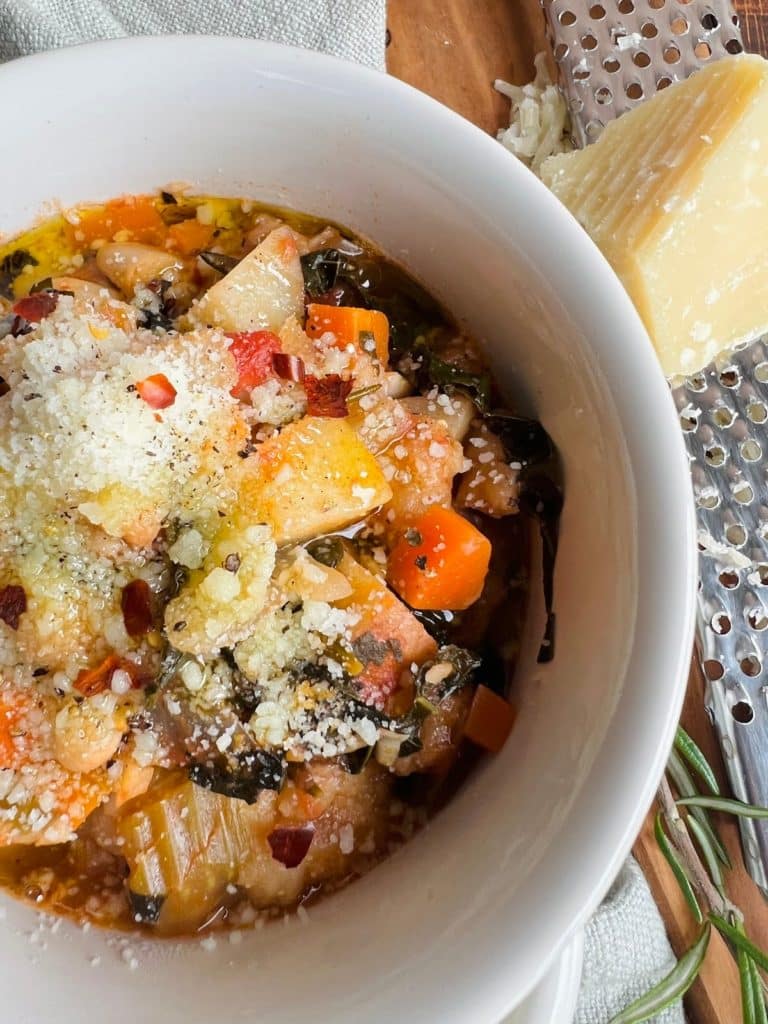
Rustic Riboliita Soup is first and foremost, Italian comfort food that is perfect for the colder months of the year, when you just want to cuddle up with a blanket and hibernate. But, it’s super-nutritious as well! This soup has so much fiber and nutrition from all of its vegetables and legumes! These include kale, cannellini beans, fennel carrots, onions, celery, tomatoes and potatoes. The bread acts as a thickener and also creates a more porridge-like consistency to the final dish. And finally, this recipe also contains a parmigiano cheese rind and lots of extra-virgin olive oil that only makes it even more rich and delicious.
For a few other veggie-forward, hearty Italian soups, check out Escarole and White Bean Soup, Lentil Soup with Sausage, Pasta with Potatoes and Italian Wedding Soup.
What Does “Riboliita” Mean?
Ribollita literally means “reboiled”, and this soup’s name is derived from the fact that peasants in the middle ages would cook a large quantity of it and then “re-boil” (i.e., reheat) it the following day (and for several days, in fact) with leftover bread. It is typical of the cucina povera style of cooking, which means it is a poor dish of humble beginnings that was developed to use up all the bits and pieces left in the kitchen, including leftover stale bread for a thicker and more filling dish.
Authentic Tuscan Ribollita Soup Three Ways
One of the things that I find so interesting about this dish is that there are really three distinct ways that you can enjoy it, each resulting in a slightly different texture. The first (and my favorite presented in the recipe below) is to layer the finished soup in a large bowl with thick slices of bread, refrigerate it overnight, then reheat the next day in a shallow pan with a little olive oil, resulting in an almost creamy, porridge-like consistency with a thin crust.
The second is to mix cubed stale bread right into the pot of finished soup, let it simmer together briefly, then serve. And the third is to simply ladle the hot, brothy soup directly over a thick slice of day-old bread placed at the bottom of a soup bowl, let it sit for a few minutes to absorb, then enjoy it.
With all three ways above, I always drizzle my portion with some really good extra-virgin olive oil, sprinkle it with some Pecorino Romano cheese, and add a little freshly ground black pepper and crushed red pepper for a truly special finish.
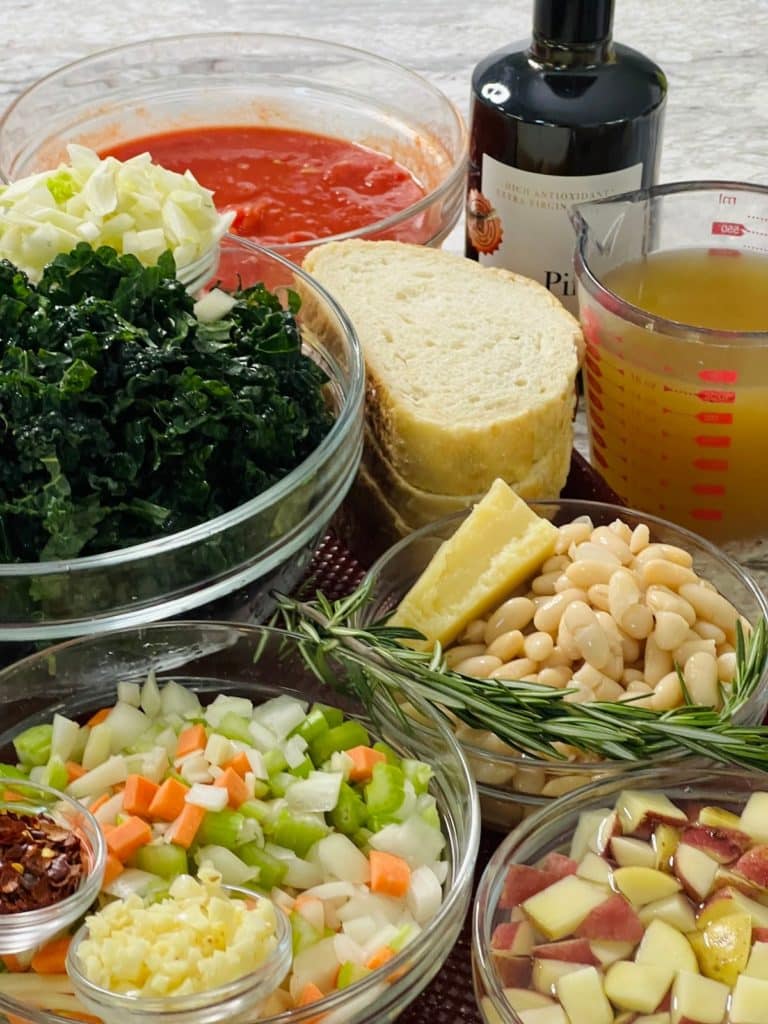
All Those Ingredients . . .
There are so many variations of this Tuscan bread and vegetable soup, but the main ingredients always include leftover bread, cannellini beans, lacinato (a.k.a., Tuscan) kale and inexpensive vegetables such as carrots, celery, potatoes and onions. But, you can totally make this recipe your own and use your favorite veggies or whatever you have on hand. Some great options include cabbage, swiss chard, spinach, borlotti beans, leeks, zucchini and parsnips. Make this Authentic Ribollita Soup recipe your own by using ingredients based on your own personal taste preferences.
And, while this soup recipe has a healthy list of ingredients, you can make almost all of the prep a day in advance. Once the vegetables are ready and chopped, the soup is extremely straightforward to make and just requires a bit of sauté, simmer and resting time.
The recipe below makes a large pot of soup and I highly recommend making the full batch. This soup really lends itself to being eaten for a few days–it truly gets better as it sits, as the flavors continue to blend together. I hope you enjoy this recipe as much as I do and make it over and over again! Enjoy!
Ingredients–What You Need
To make Authentic Tuscan Ribollita Soup, we will be using the following ingredients:
- Bread: Bread is really the defining ingredient in this soup, in my opinion. The bread acts as a thickener and absorbs most of the juices of the soup as it sits, creating a very dense, stew or porridge-like consistency. Day-old, and several days old, Italian or French bread is perfect to use in this soup. Having said this, fresh bread can also be used in this recipe and is wonderful.
- Cannellini Beans: I am in favor of high-quality canned beans and use them regularly. This is one dish that works beautifully with canned beans. Of course, starting with dried beans and then soaking and cooking them is a great idea and very cost effective! The only wild card is to whether or not to use the starchy liquid that comes with the canned beans. This is a personal choice, but here is my advice: if you buy no- or low-sodium high quality (preferably organic) canned beans, then it is okay to use the bean liquid. Otherwise, you may end up with an overly salty, briny and strange tasting liquid in your dish. If you choose not to use the canned bean liquid and have homemade chicken stock available, the collagen in the stock will create texture in the final dish. Otherwise, just use additional vegetable or chicken broth in place of the bean liquid.
- Lacinato Kale, Fennel, Potatoes: You’ll find lots of different combinations of vegetables in different ribollita recipes. My selections were based on the original recipe that I learned in Tuscany years ago. Lacinato kale, which is also known as Tuscan, dinosaur or black kale (from its Italian name cavolo nero) can be substituted with Swiss chard or cabbage.
- Canned Tomatoes: Adds umami (savoriness) and a depth of flavor to the soup. I generally prefer to use canned whole tomatoes and hand crush them. But, you can also use canned diced tomatoes for convenience. I do not suggest tomato puree for this recipe as it doesn’t have the texture needed for this soup.
- Onions, Carrots, Celery, Garlic: These ingredients are important components in building a strong base of flavor in many soups. They also add texture and nutrition!
- Broth (vegetable): Homemade is always preferred. If purchased, I suggest a low- or no-sodium version. (Regular varieties are laden with sodium and it’s always best for you to control the amount of salt yourself!) Chicken broth can be used as well, but the final dish will not be vegetarian.
- Olive Oil: Used to sauté the vegetables. In addition, I suggest drizzling each bowl of soup with some very high-quality finishing oil, such as Olio Piro.
- Parmigiano-Reggiano Cheese: The rind adds a savory depth and body to the finished soup. As the soup simmers, the rind will dissolve some (or entirely based on how much you used), imparting richness and flavor. And, a sprinkling of grated parmigiano on each individual serving of soup brings the dish to another level–in a good way!
- Fresh Rosemary: Adds lots of flavor. Rosemary is a very fragrant herbs and a little goes a long way!
A complete and detailed list of ingredients with amounts and instructions is included in the recipe below.
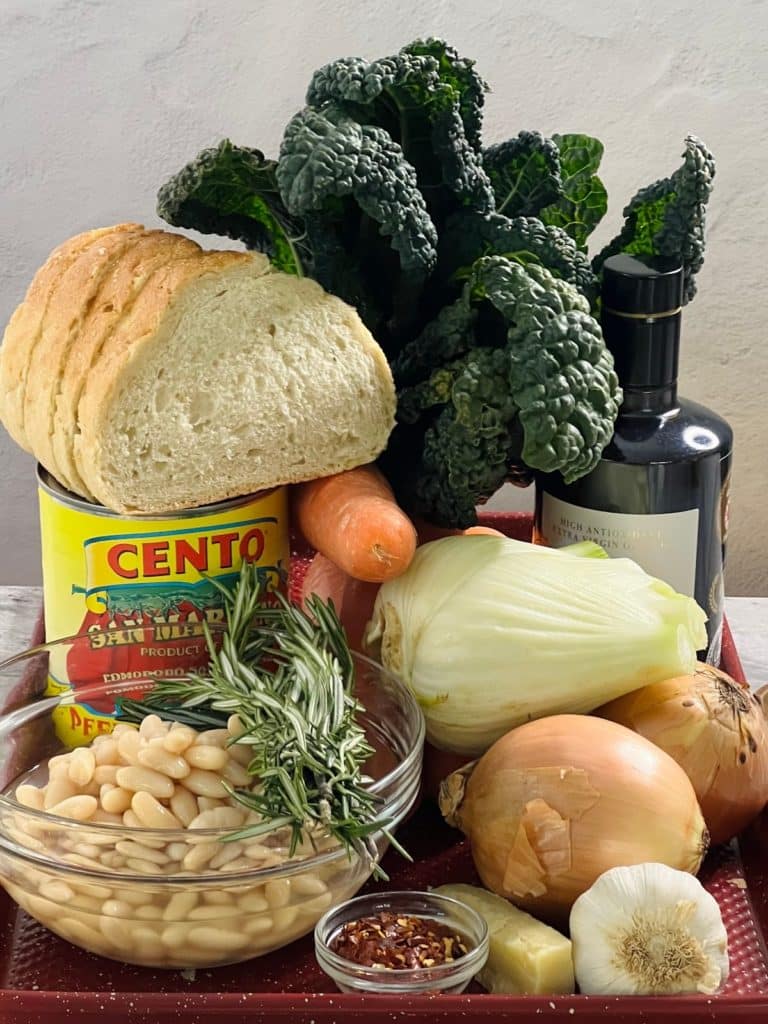
Step-By-Step Photos & Instructions, Pro-Tips included!
Here are the main steps for how to make Authentic Tuscan Ribollita Soup:
- Prep and measure all ingredients. Be sure to rinse or peel all vegetables before using.
- PRO-TIP: Feel free to coarsely chop the onions, carrots, celery and garlic in a food processor to save time. And, you can prep the vegetables in advance and store them in a zip-lock bag in the refrigerator for up to one day.
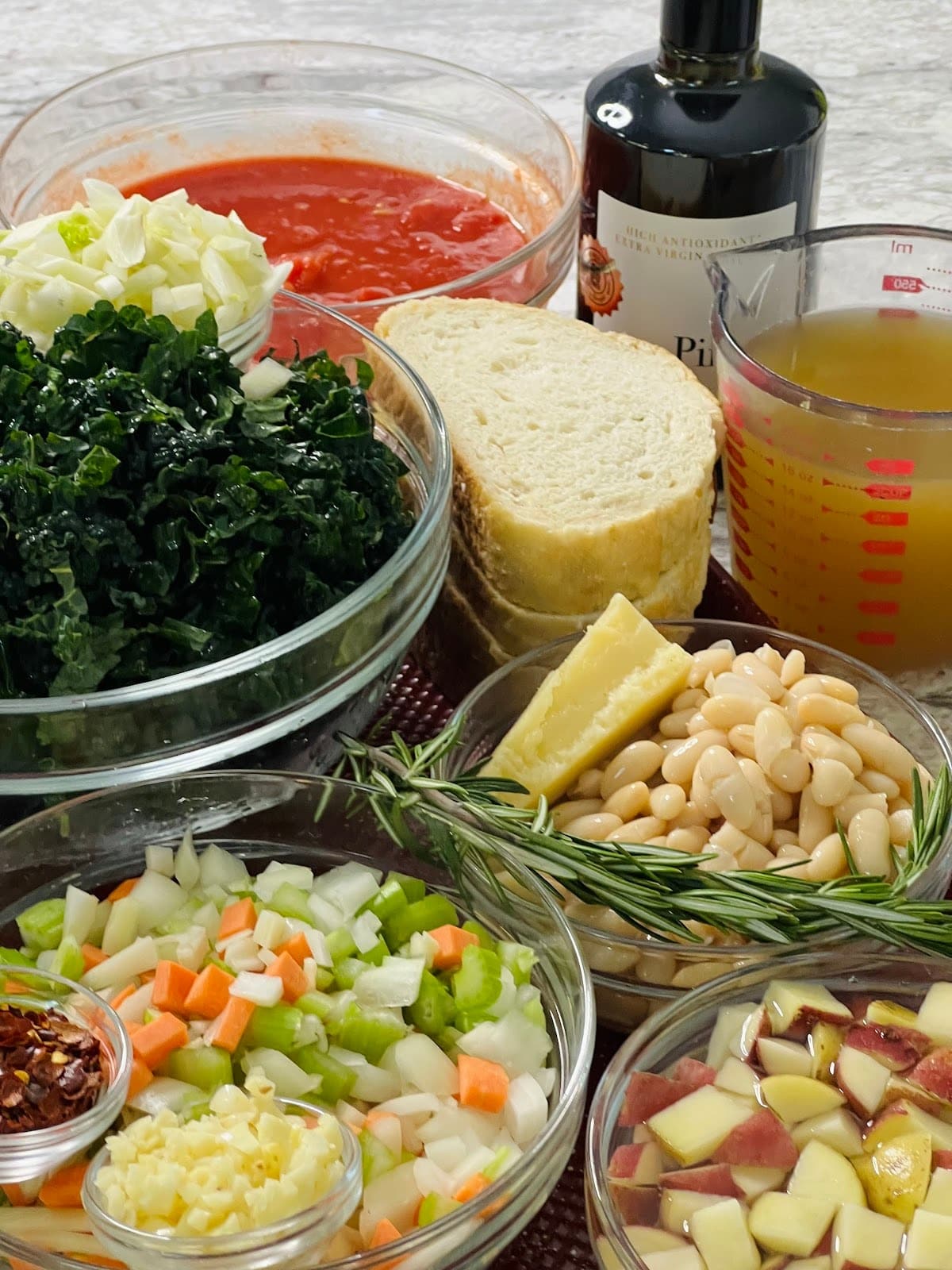
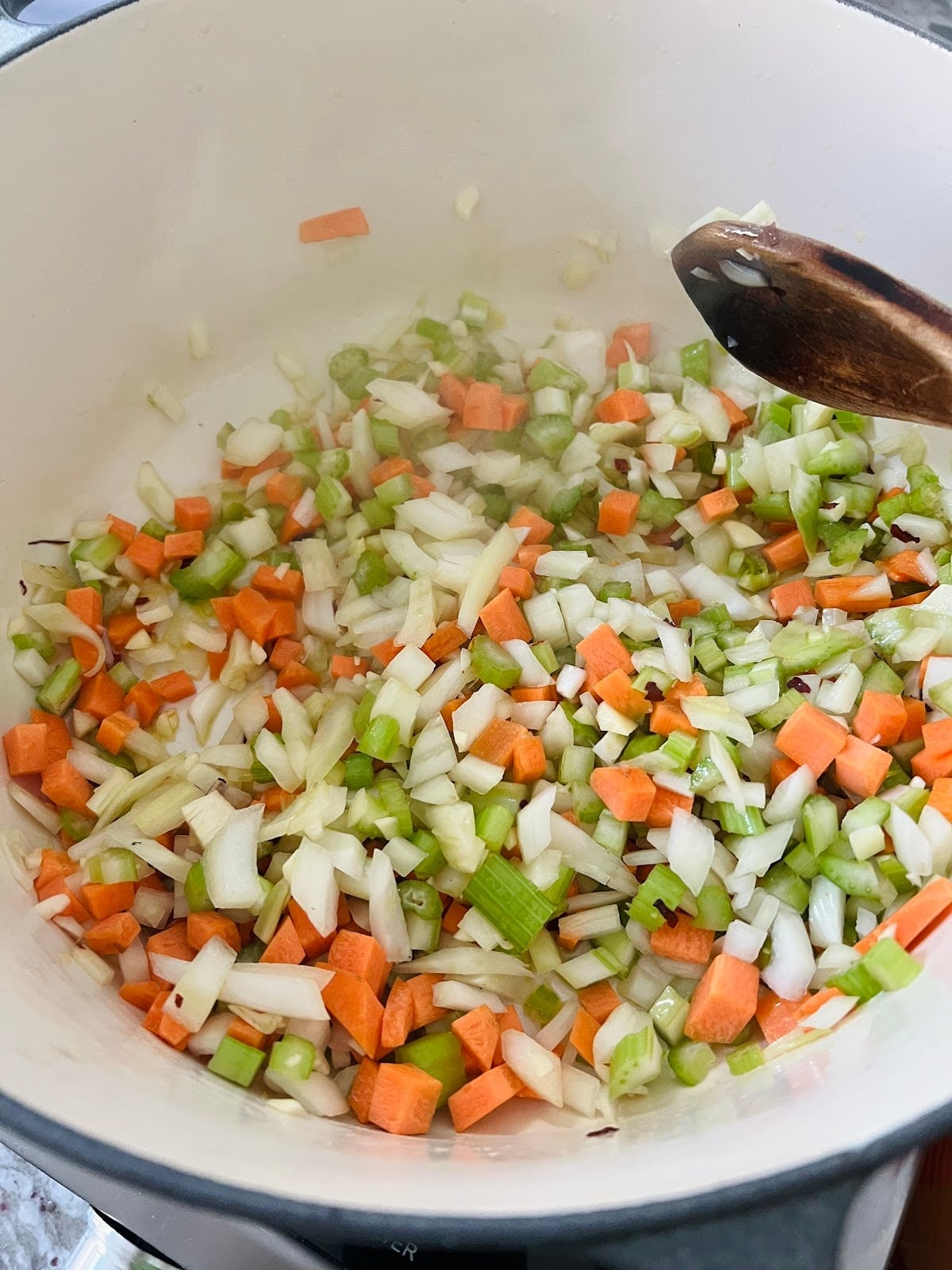
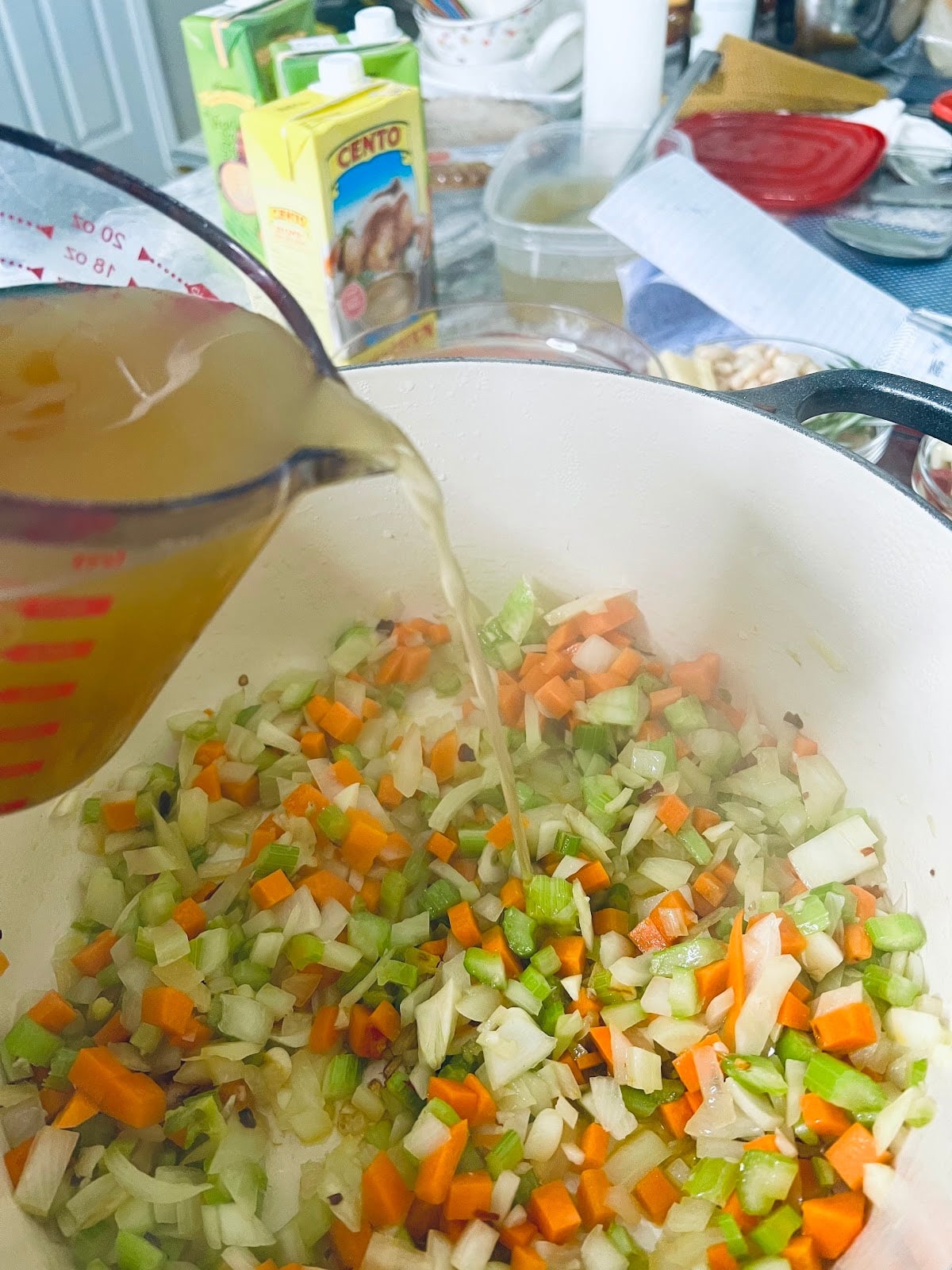
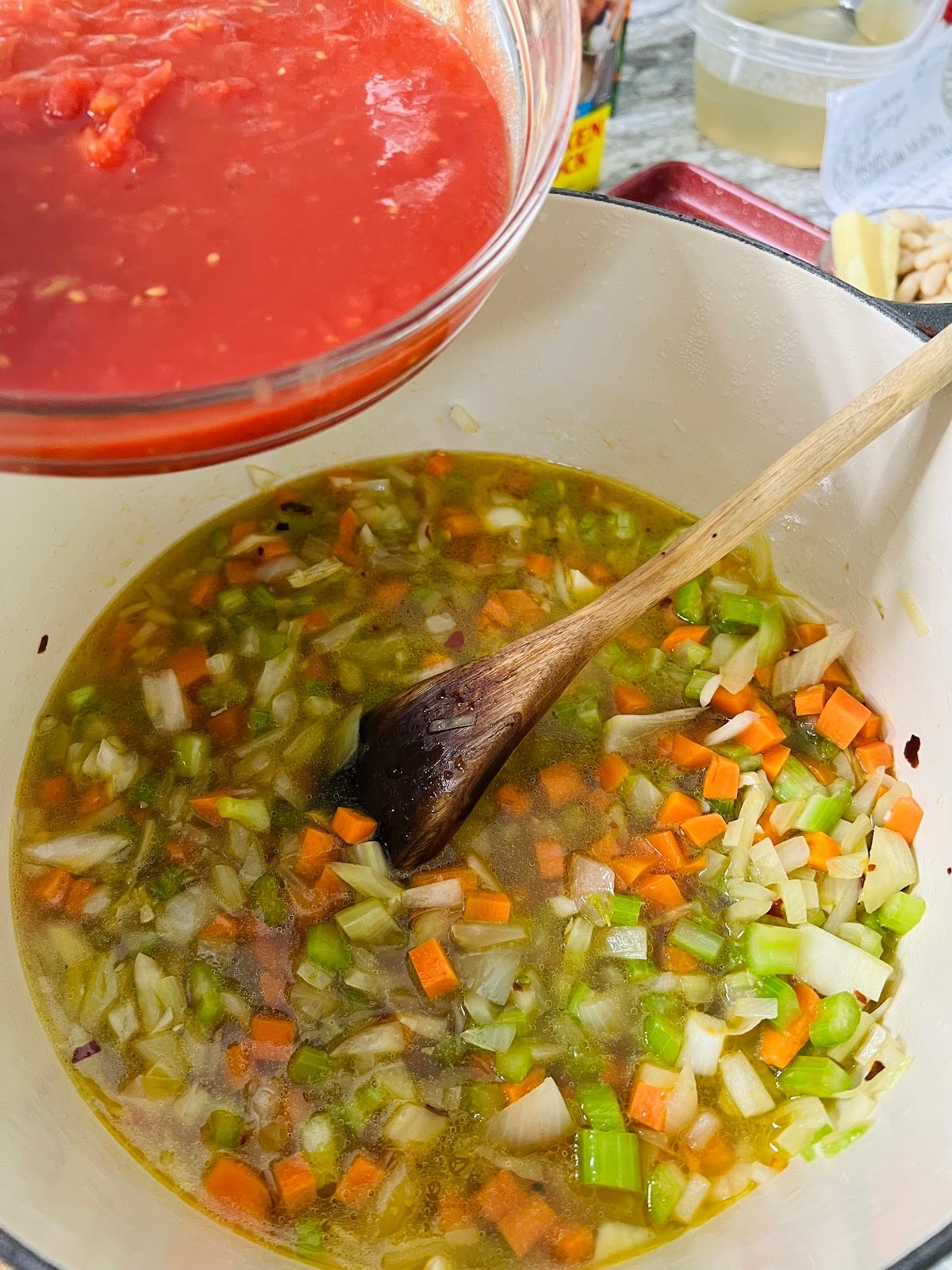

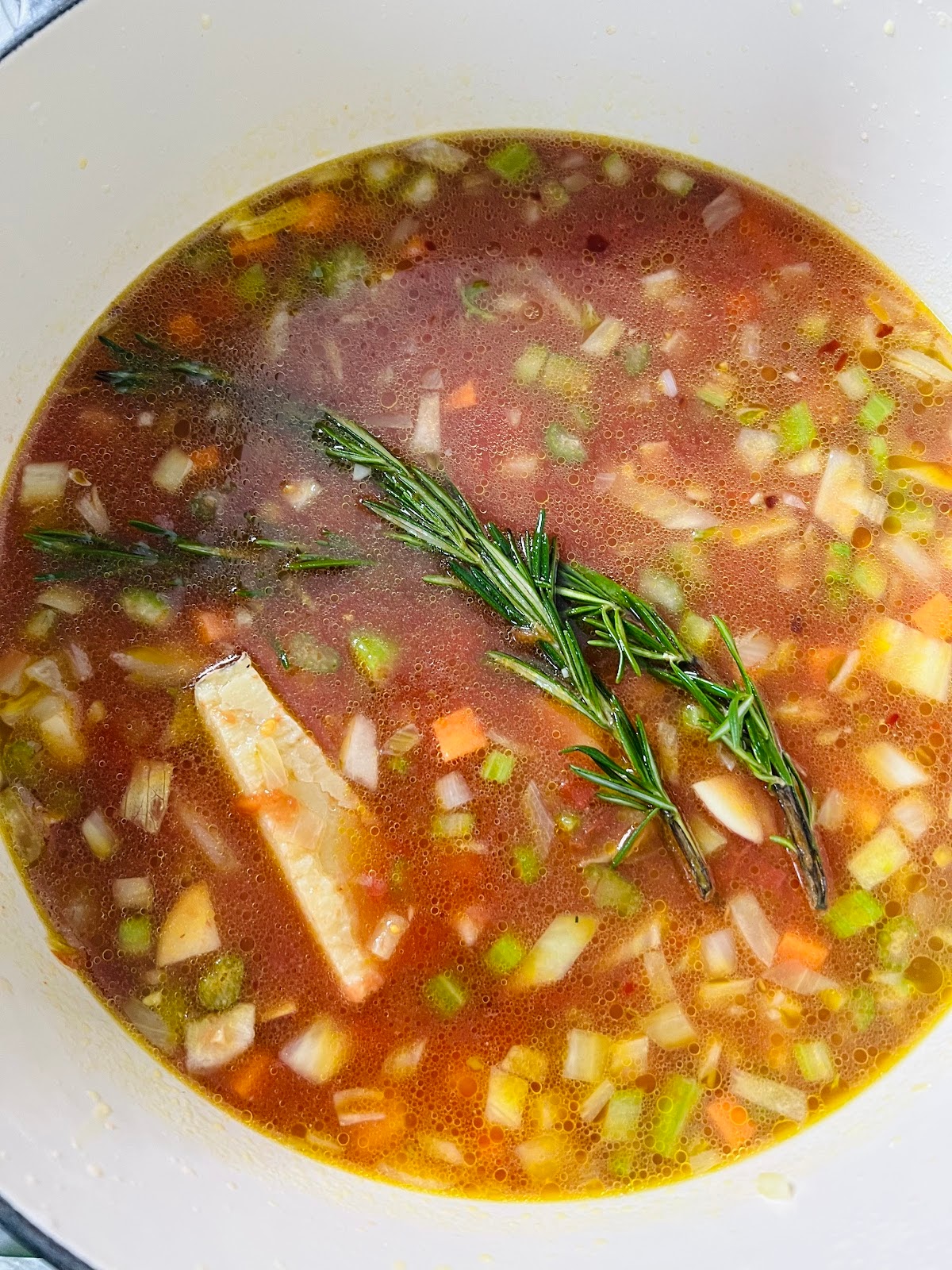
- Heat oil, then add onions, celery, carrots, fennel, garlic and crushed red pepper and cook until vegetables have softened a bit, stirring occasionally.
- Add broth and stir to deglaze, loosening and scraping up any browned bits on bottom of pot. Then, add tomatoes, bean cooking liquid, potatoes, rosemary sprigs, cheese rind, salt and black pepper and stir until all ingredients are well-combined. Simmer, partially covered, for about 10 minutes, stirring regularly.
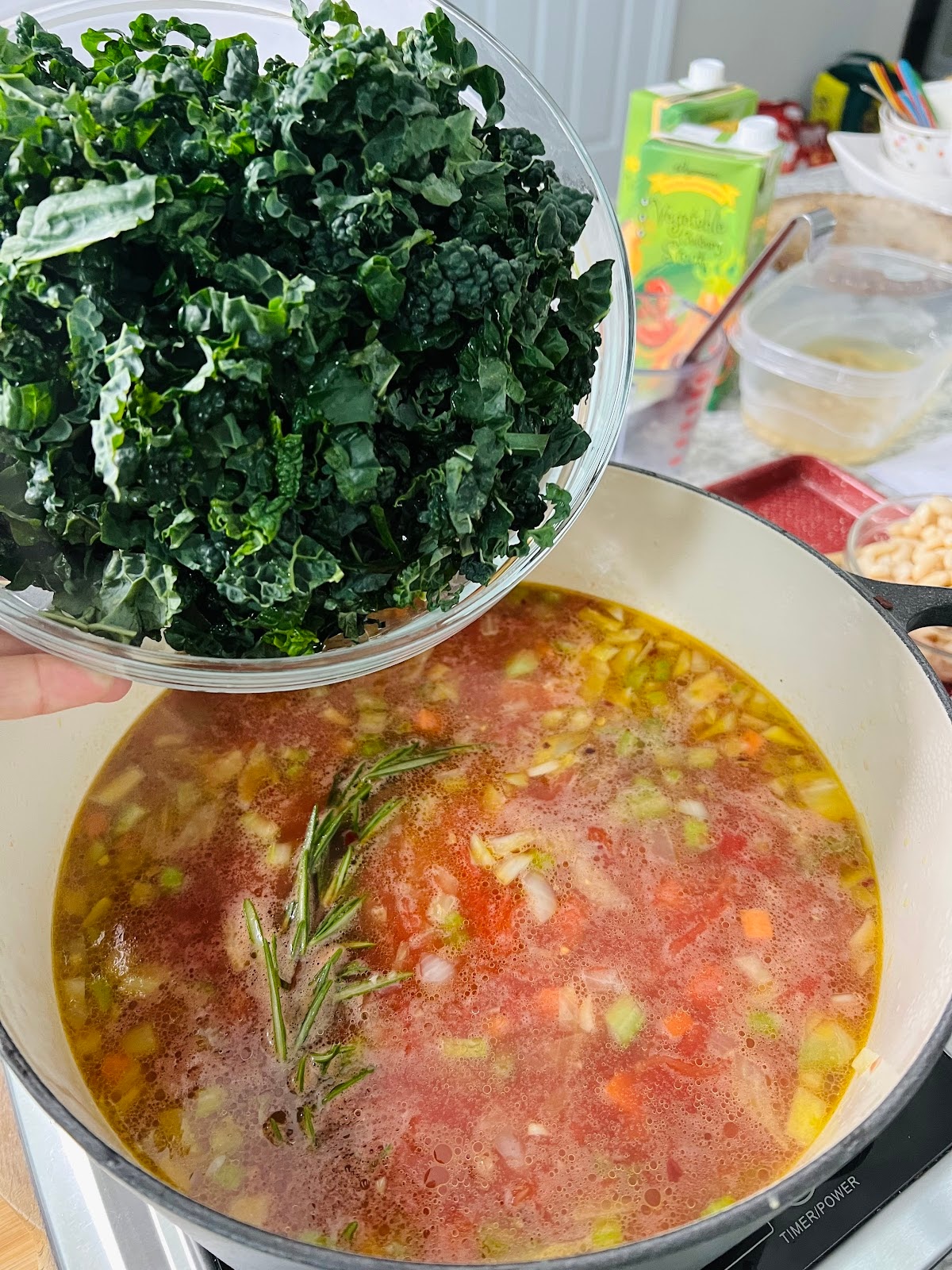
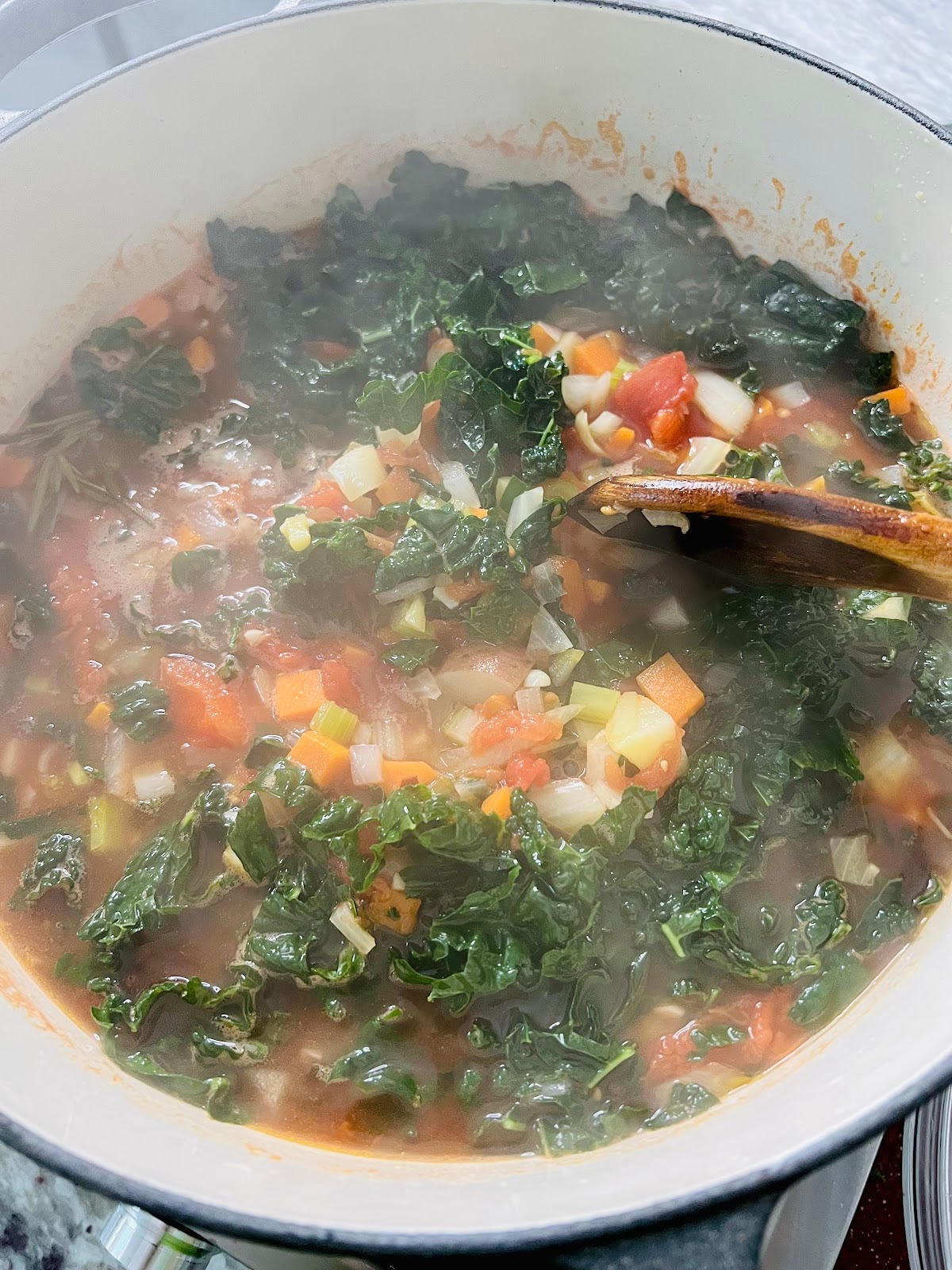
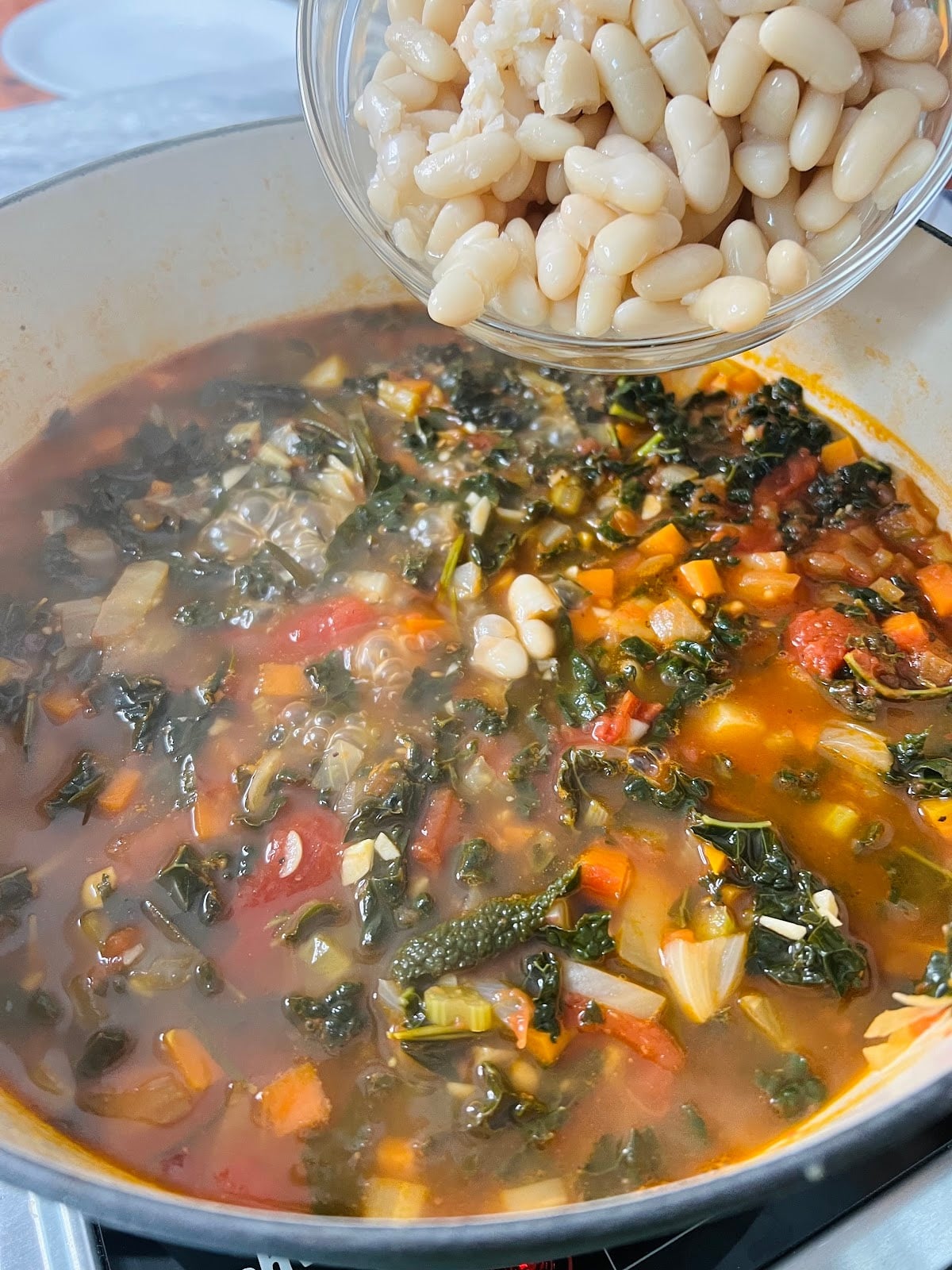
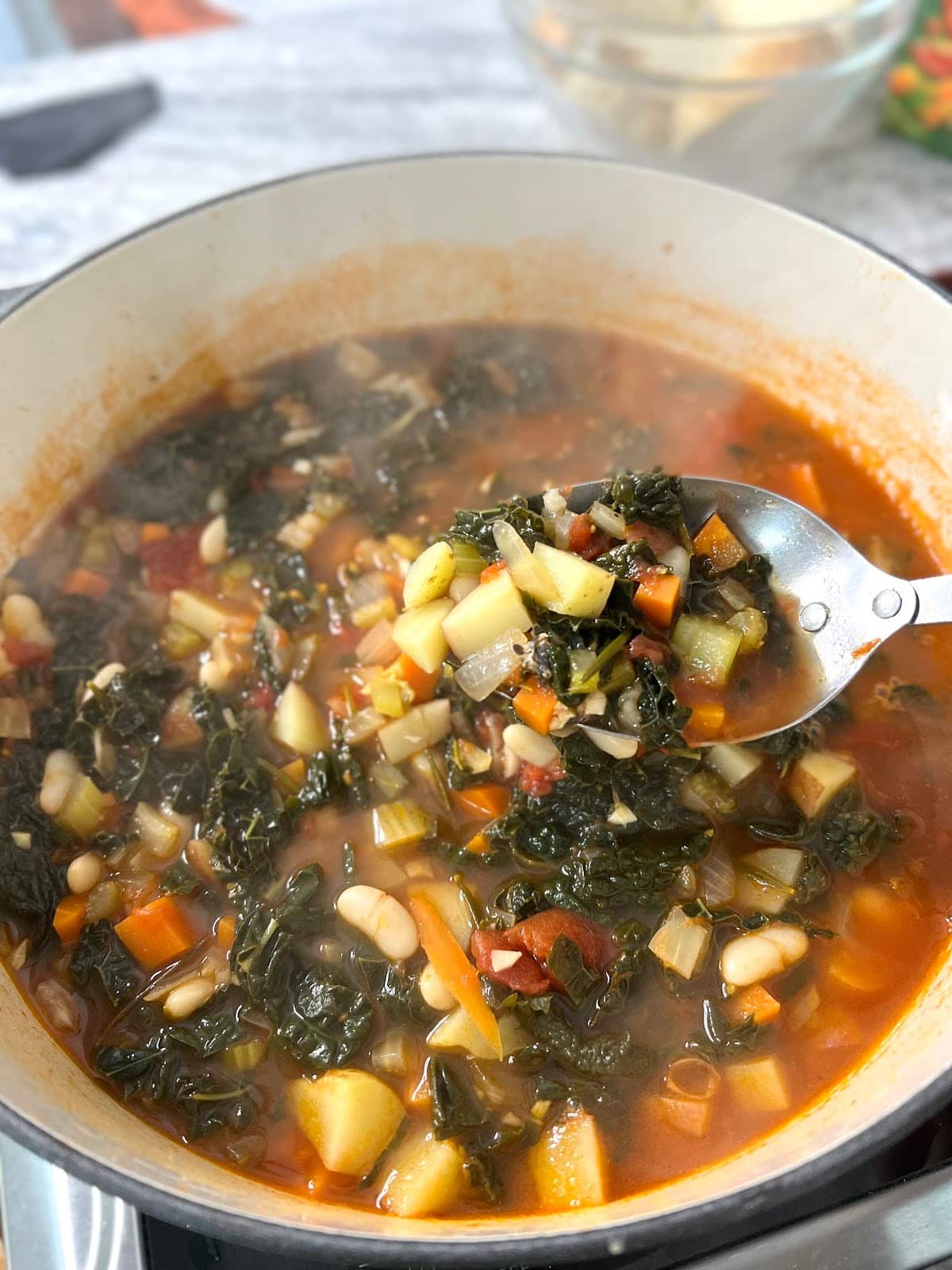
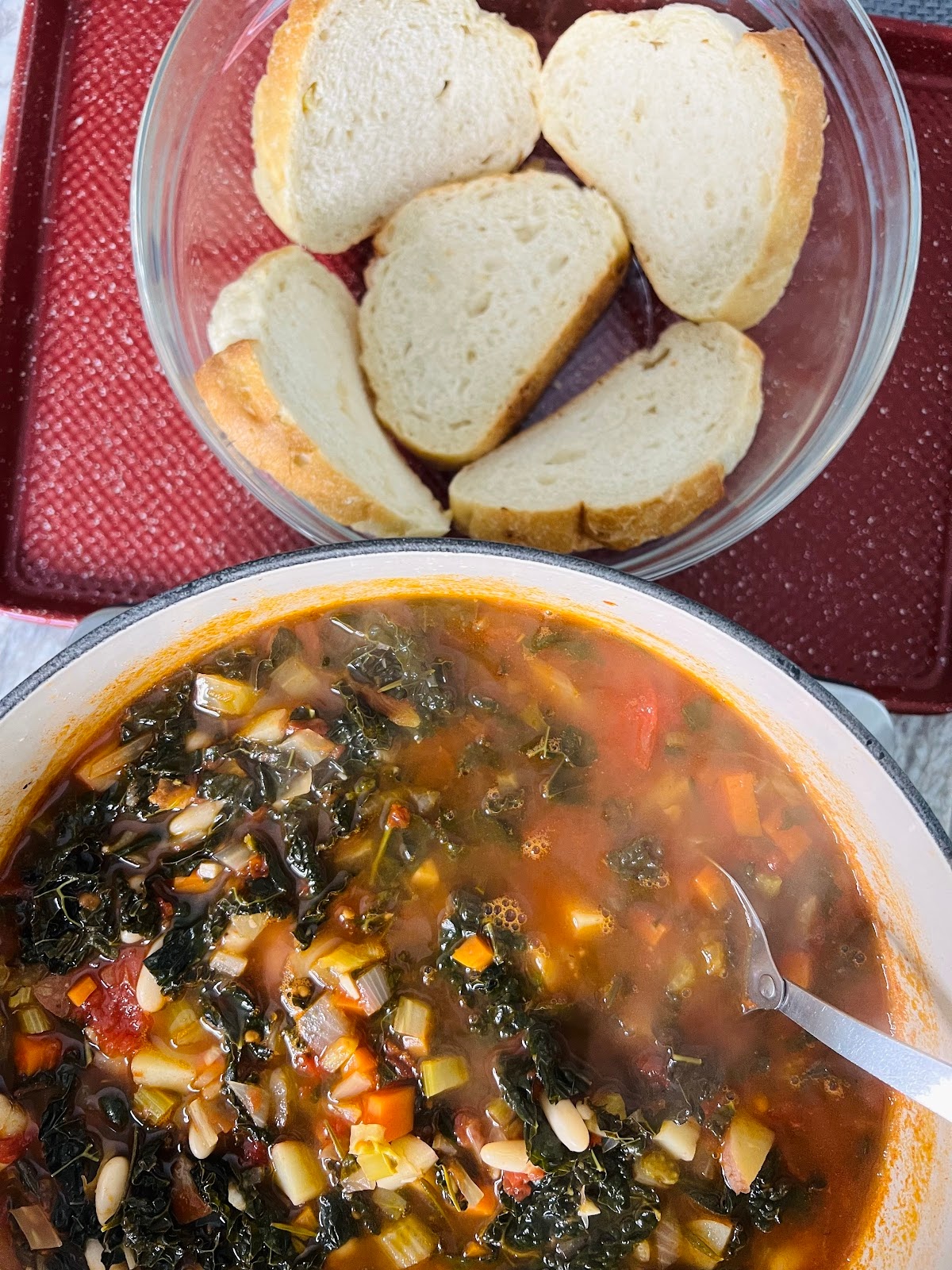
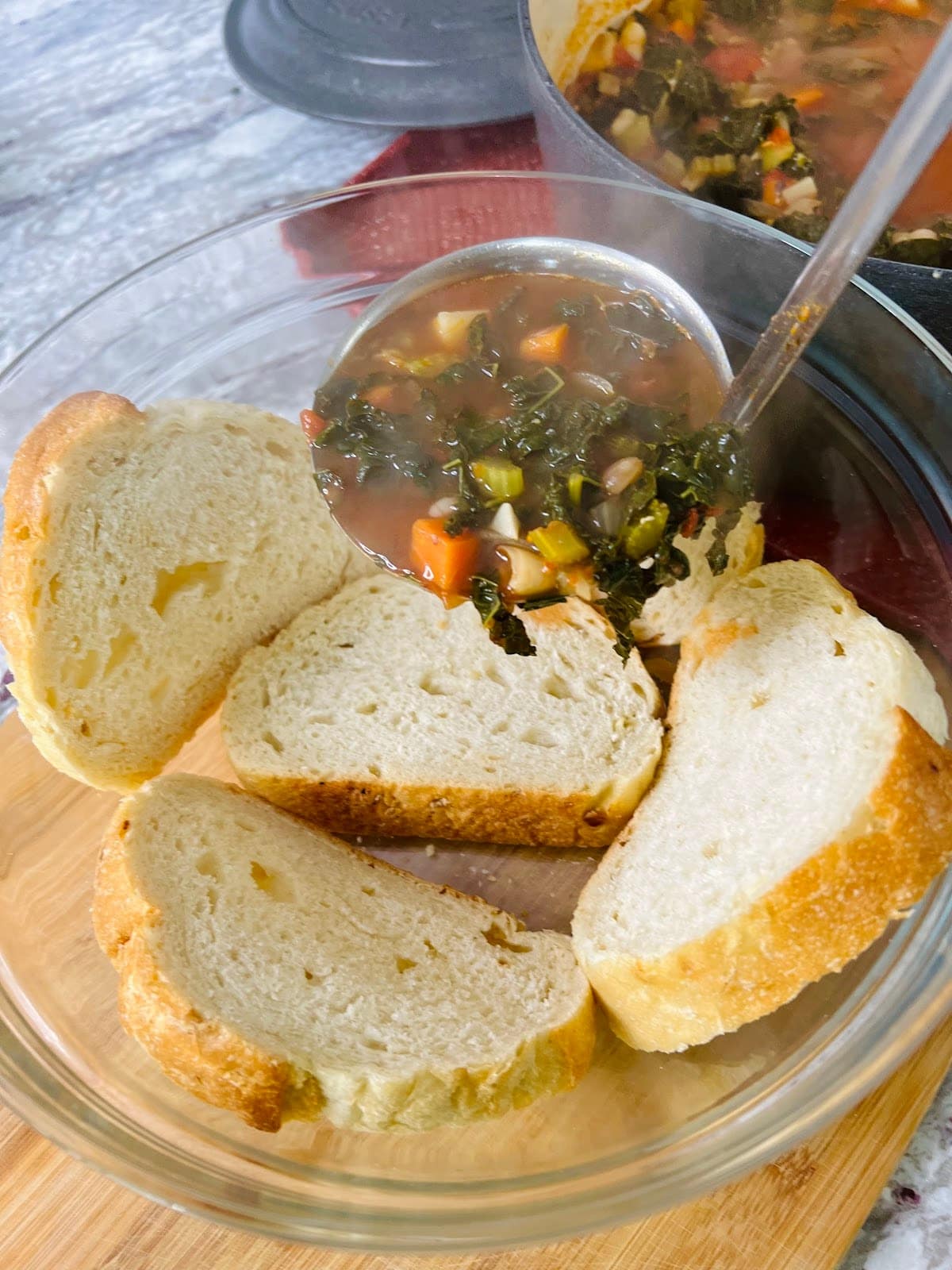
- Stir in kale and continue to cook until the potatoes are soft, about 15 to 20 more minutes. The soup should be rather thick; add more broth if needed. Stir in beans about 5 minutes before the soup is done. Remove the rosemary stems, then taste and adjust seasonings and turn off heat.
- PRO-TIP: If you use canned beans to make this dish, the only wild card is to whether or not to use the starchy liquid that comes with the canned beans. This is a personal choice, but here is my advice: if you buy no- or low-sodium high quality (preferably organic) canned beans, then it is probably okay to use the bean liquid. Otherwise, you may end up with an overly salty, briny and strange tasting liquid in your dish. If you choose not to use the canned bean liquid and have homemade chicken stock available, the collagen in the stock will create texture in the final dish. Otherwise, just use some vegetable or chicken broth in place of the bean liquid in this recipe.
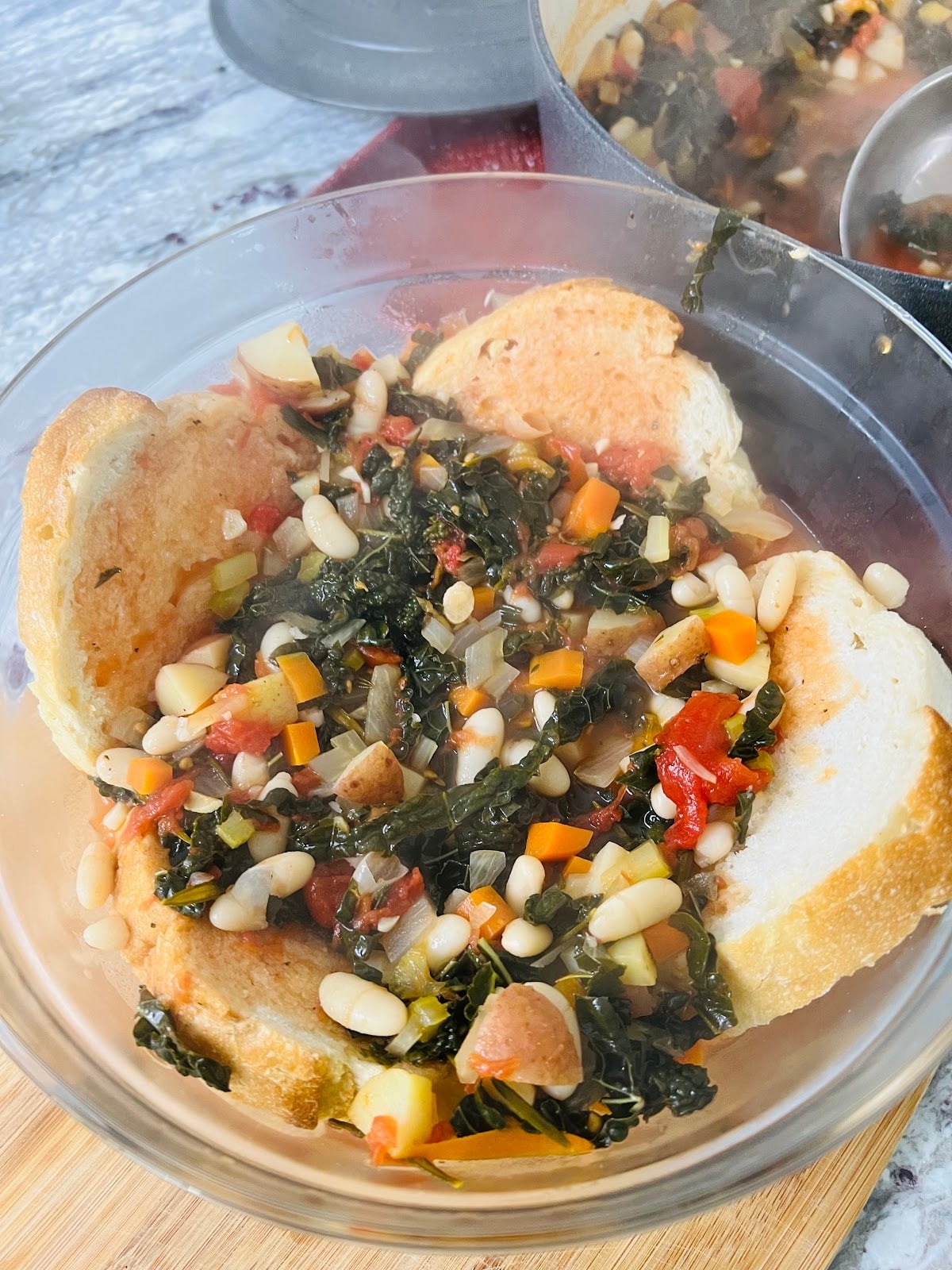
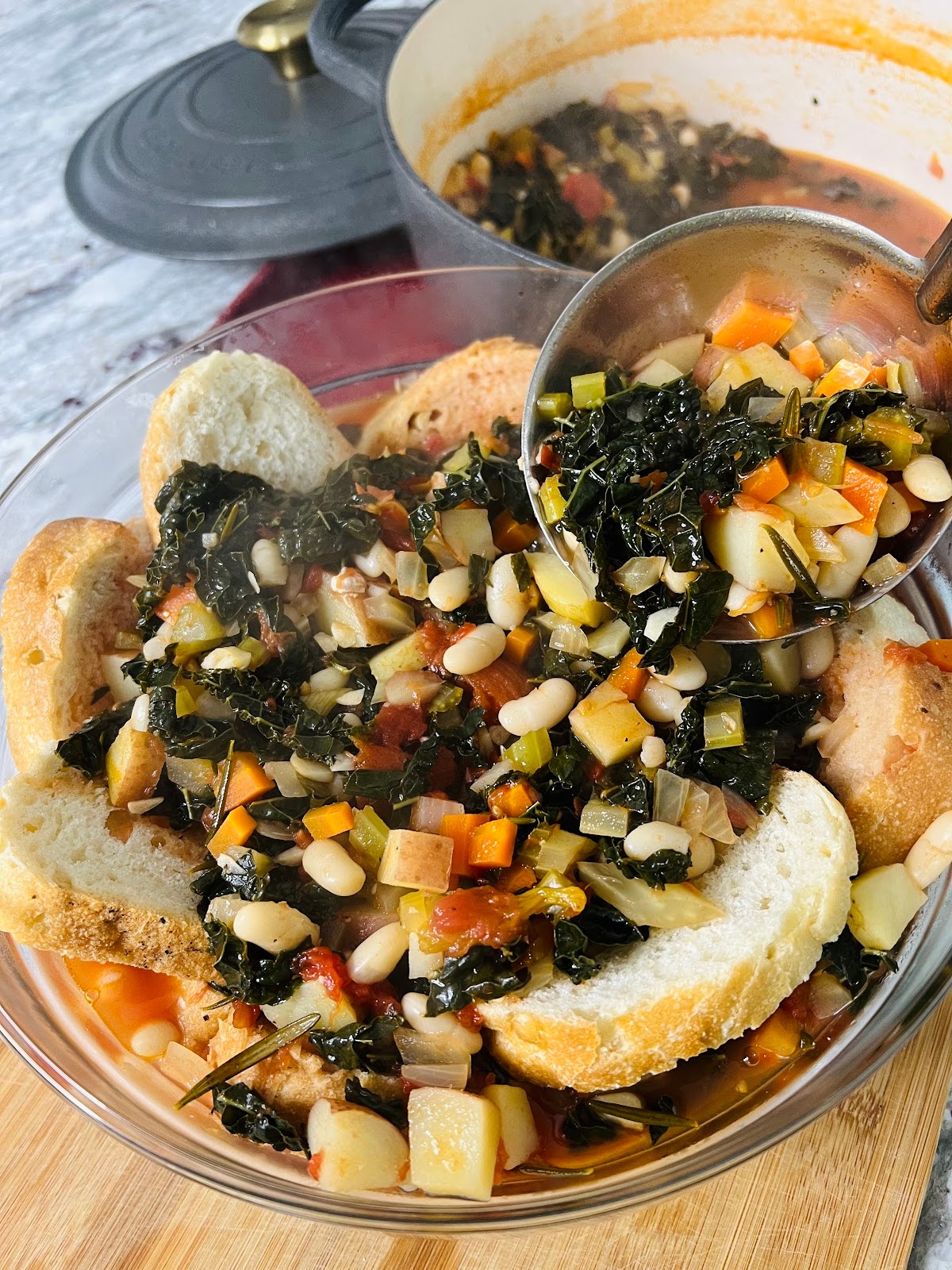
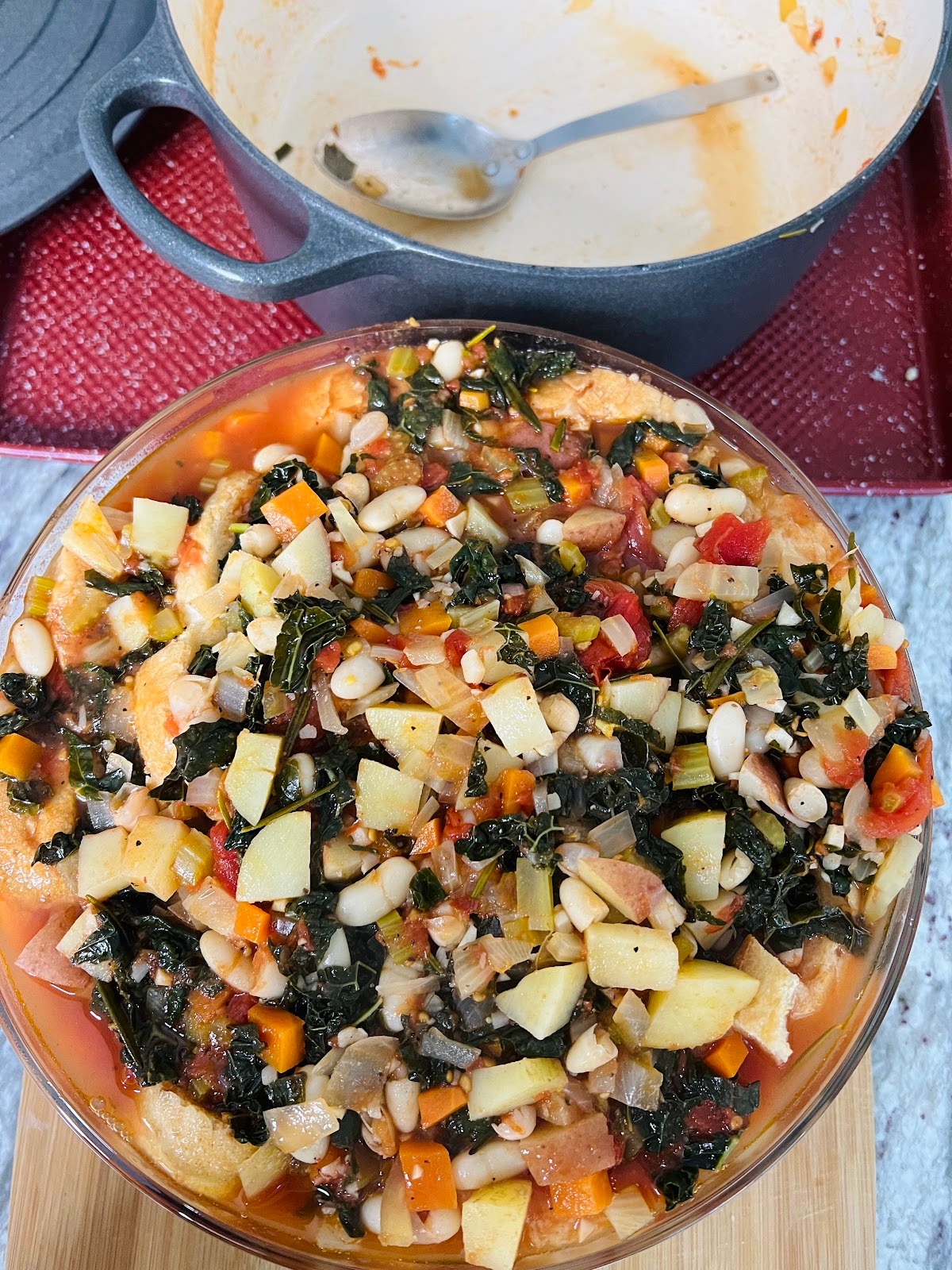
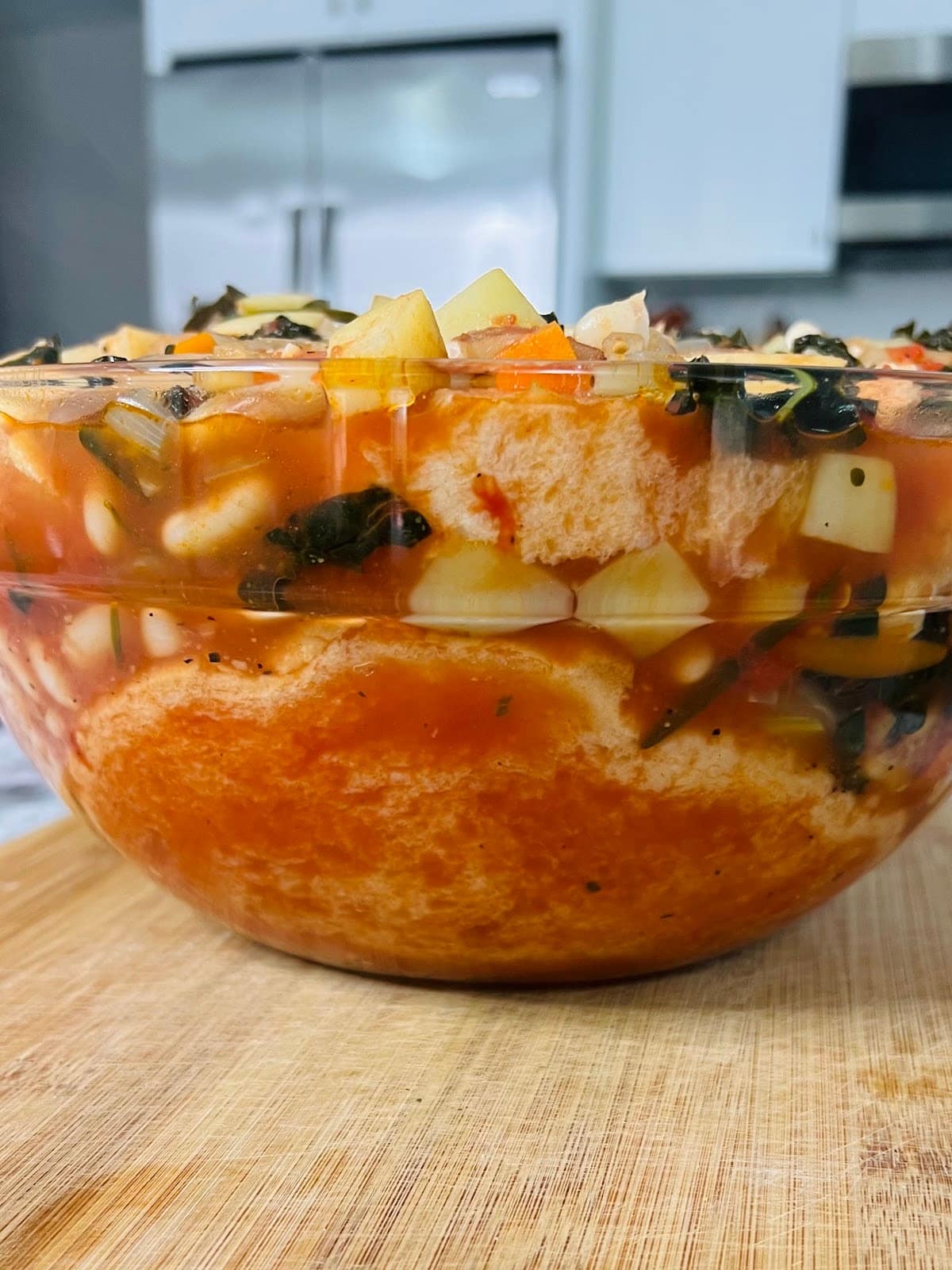
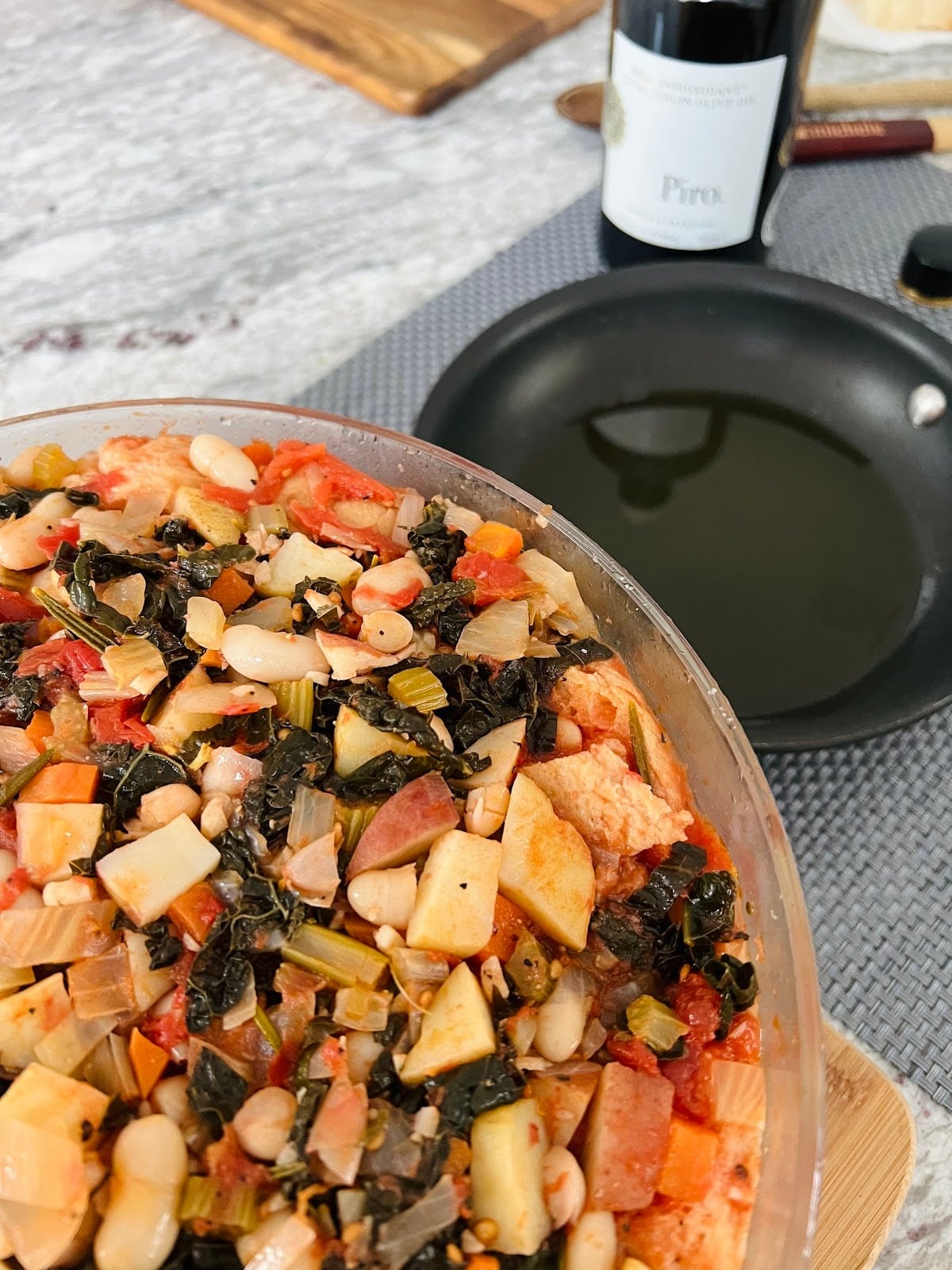
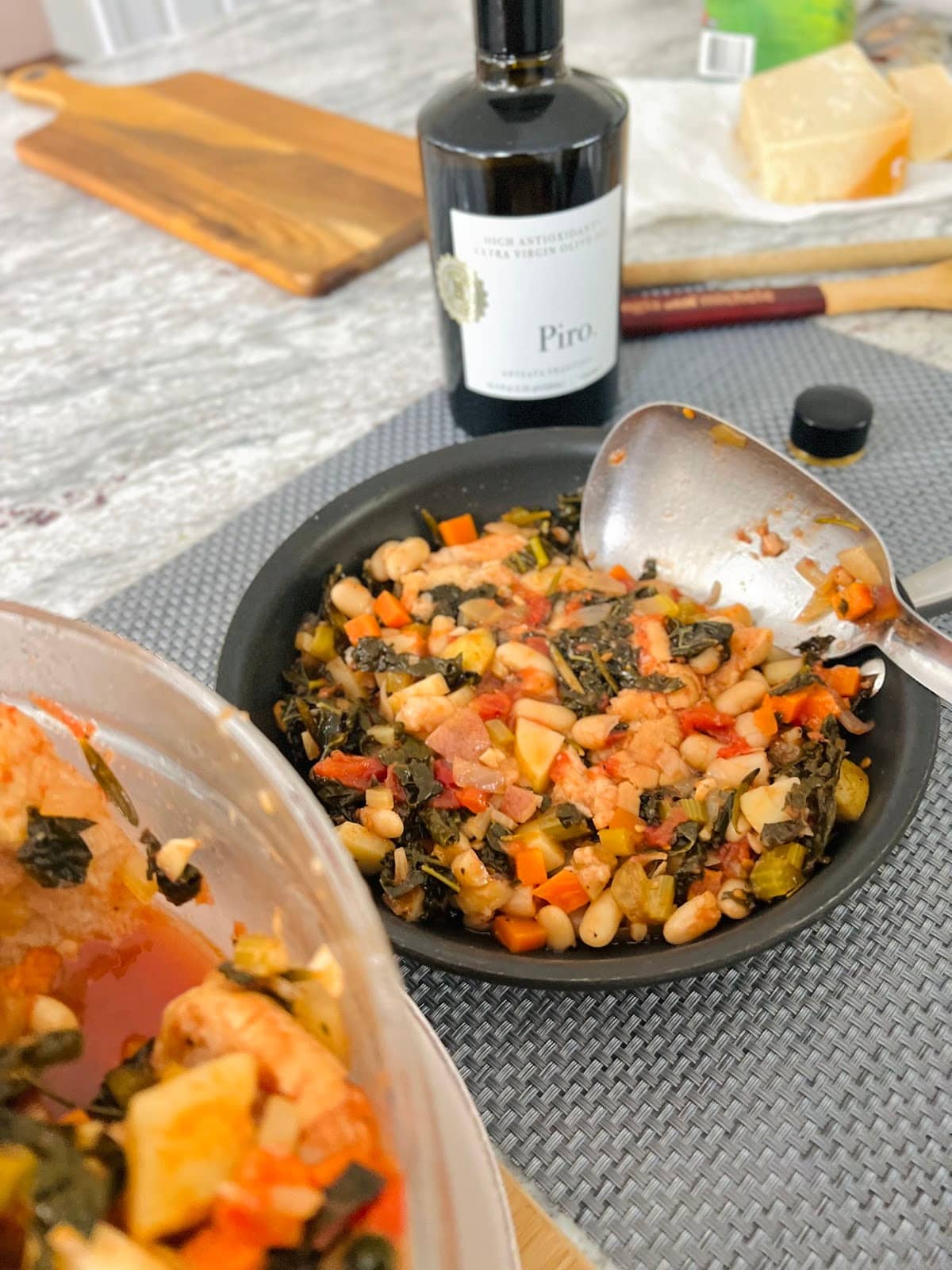
- Arrange a layer of bread in a large bowl, then ladle some soup over the bread. Repeat this layering of bread and soup until all the bread and soup are used up, finishing with a layer of soup. Press the bread down to ensure that it is all immersed in the soup. Let this cool for about 30 minutes, then cover and refrigerate overnight.
- The following day, serve the ribollita. You can reheat it in one of two ways. The first and my favorite way is to heat some olive oil in a skillet, then add some now very thick, stew-like soup to it and heat until an irresistible, thin crust forms. The second way is to heat the ribollita in a pot in a more traditional way, with a bit more liquid (broth or water) added. With either reheating method, some high-quality extra-virgin olive oil should be drizzled over each serving with a sprinkling of either parmigiano or pecorino cheese for an additional hit of flavor and richness.
- ALTERNATIVE (QUICKER) METHOD: Slice the bread slices into cubes, then fold bread cubes into the soup about 5 minutes after the addition of the beans. Continue to simmer the soup for about 5 to 10 more minutes while stirring. The bread will break apart and further thicken the soup. Then, ladle the soup into bowls, topping each portion with a generous drizzle of high-quality, extra virgin olive oil and a sprinkling of either parmigiano or pecorino cheese.
- PRO-TIP: Due to the addition of bread, this soup does not actually freeze well. However, if you decide to forego the bread, this soup will freeze beautifully in an airtight container for up to two months.
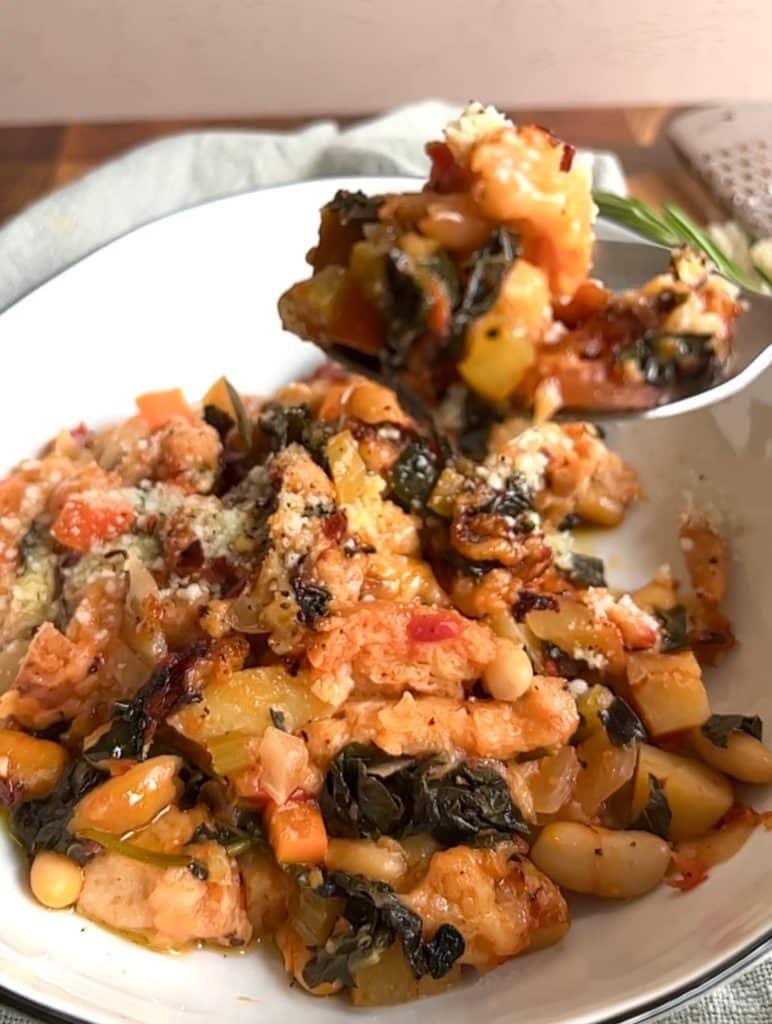
Frequently Asked Questions
Here are answers to some frequently asked questions for this Authentic Tuscan Ribollita Soup recipe:
What kinds of substitutions are acceptable in this recipe?
You can totally make this recipe your own and use your favorite veggies or whatever you have on hand. Some great options include cabbage, swiss chard, spinach, borlotti beans, leeks, zucchini and parsnips. Make this Ribollita Soup recipe your own by using ingredients based on your own personal taste preferences.
Do I have to use the bread?
Of course not. I always encourage everyone to customize each recipe and try some twists on it. I’ve presented here the very traditional way of making this recipe in Tuscany, the Italian region in which it originated. But, without the bread, it’s still a beautiful and hearty vegetable and bean soup. Alternatively, any form of mini-pasta, such as ditalini, would be wonderful in this soup in place of the bread. (Just cook the pasta separately, then add it to the finished soup).
Is Authentic Tuscan Ribollita Soup vegetarian or vegan?
It can easily be! My recipe contains parmigiano cheese, which is made with animal rennet. So, it is not technically vegetarian. Leave the cheese out completely and this recipe is not only vegetarian, but also vegan.
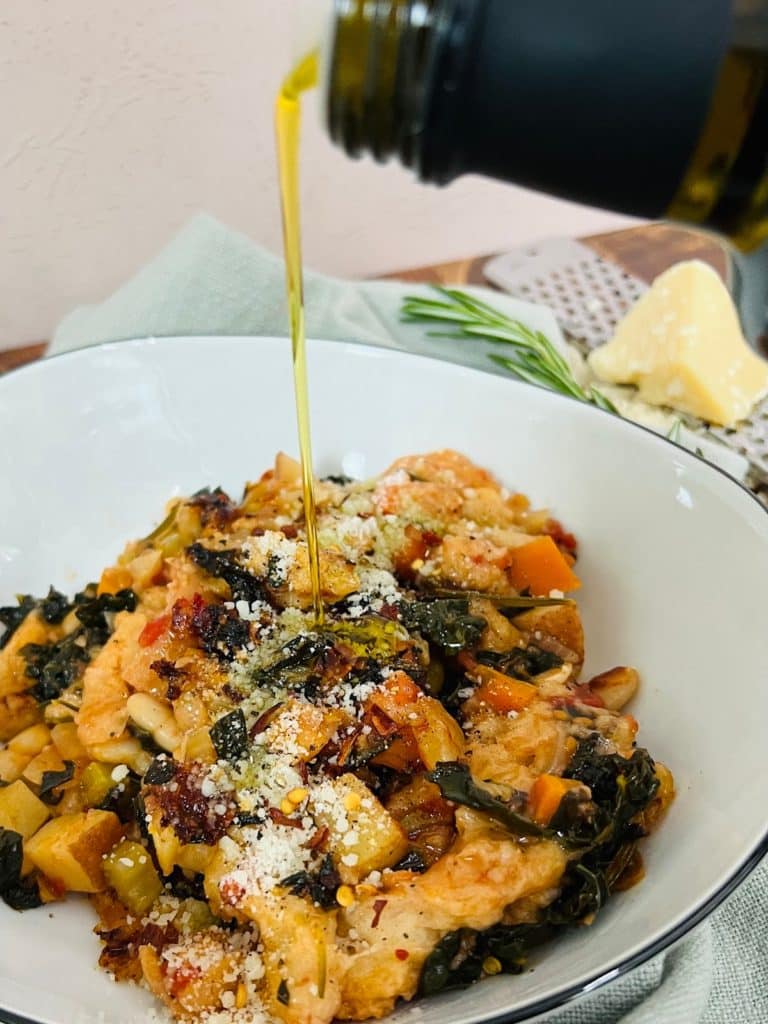
Recipe Ideas for Authentic Tuscan Ribollita Soup
I’ve made this recipe so many times and make it a little bit different every time. That’s the beauty of this recipe and dish–you can absolutely make it your own. Switch up the recipes or beans as you desire.
And, that goes for the leftovers as well! If you’ve had the ribollita for a day or two already and want a change, consider adding a few meatballs to it for additional protein or cracking an egg right in the center of it (in the spirit of Eggs in Purgatory). The possibilities are endless!
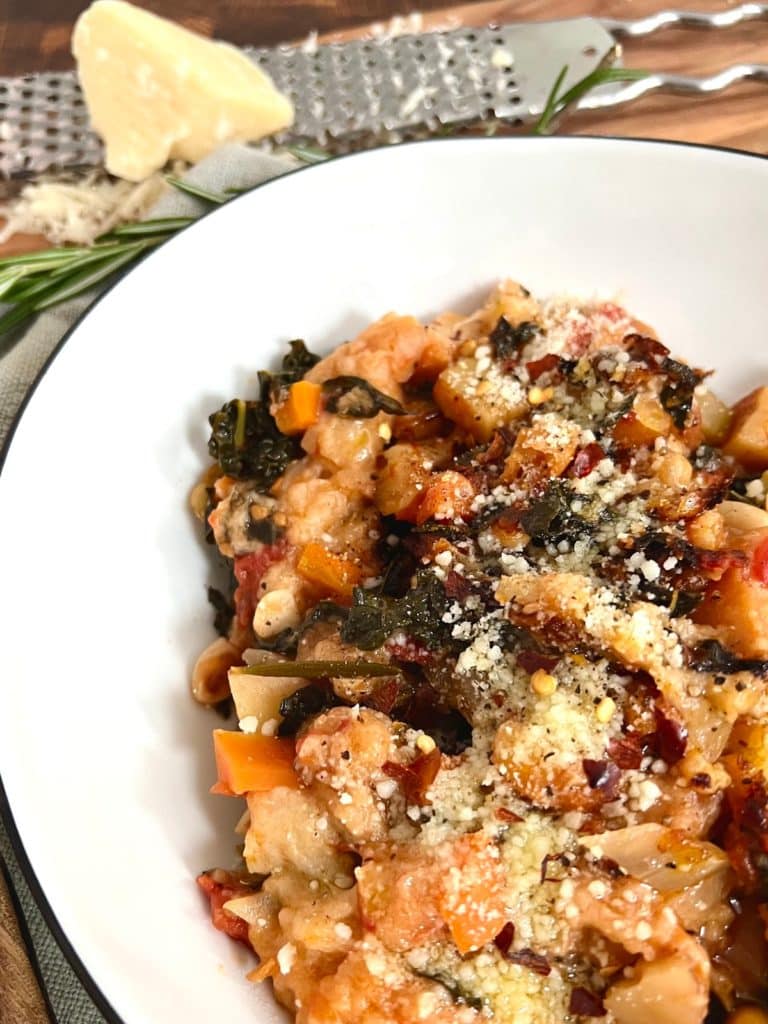
Kitchen Tools for Authentic Tuscan Ribollita Soup
To make this recipe, you will need the following:
- Cutting board with non-slip mat underneath (I use shelf liner)
- Sharp chef’s knife
- Measuring cups and spoons
- Multiple bowls to hold prep
- Serrated knife
- Vegetable peeler
- Can opener
- Large pot or Dutch oven
- Large wooden or stainless steel spoon to stir soup
- Cheese grater (optional)
- Serving ladle

More Great Recipes to Try
I hope that you are enjoying my Italian food blog Mangia With Michele and all of my Italian recipes and Italian-American recipes!
If you’ve tried this Authentic Tuscan Ribollita Soup recipe or any other recipe on the blog, please let me know how it went in the comments below — I love hearing from you!
You can also FOLLOW ME on FACEBOOK and INSTAGRAM to see more delicious food and what might be going on behind the scenes!
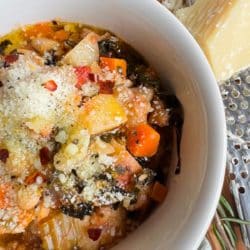
Authentic Tuscan Ribollita Soup
Ingredients
- ¼ cup olive oil
- 1 cup small diced yellow onions
- 1 cup small diced celery
- 1 cup small diced carrots
- 1 cup small diced fennel
- 2 Tbsp chopped garlic
- ¼ tsp crushed red pepper
- 4 cups low-sodium vegetable broth
- 1 (28 ounce) can whole tomatoes, hand-crushed
- 1 cup bean cooking liquid (or additional broth)
- ¾ pound Yukon gold or russet potatoes cut into ½-inch pieces, held in cold water to prevent browning
- 2 rosemary sprigs
- 1 parmigiano or pecorino cheese rind
- 2 tsp salt (or to taste)
- 1 tsp ground black pepper
- ¾ pound chopped lacinato kale leaves stems removed (about 12 cups)
- 2 cups cooked cannellini beans (about 12 ounces dried beans, if using)
- 8-10 thick slices day-old Italian or French bread (about ¾ to 1 pound)
- High quality, extra-virgin olive oil, for serving
- Grated parmigiano or pecorino cheese, for serving
Instructions
- Prep all ingredients according to specifications above.
- Heat oil in a 6-quart (or larger) pot or Dutch oven over medium-high heat. Add onions, celery, carrots, fennel, garlic and crushed red pepper and cook for about six minutes, or until vegetables have softened a bit, stirring occasionally.
- Add 2 cups broth and stir to deglaze, loosening and scraping up any browned bits on bottom of pot. Then, add remaining broth, tomatoes, bean cooking liquid, potatoes (drain first if being held in water), rosemary sprigs, cheese rind, salt and black pepper and stir until all ingredients are well-combined.
- Cover pot, increase heat and bring mixture to a boil. Then, immediately reduce heat to a simmer and simmer, partially covered, for about 10 minutes, stirring regularly. Stir in kale and continue to cook until the potatoes are soft, about 15 to 20 more minutes. The soup should be rather thick; add more broth if needed. Stir in beans about 5 minutes before the soup is done. Remove the rosemary stems and what’s left of the parm rind, then taste and adjust seasonings and turn off heat.
- Arrange a layer of bread in a large glass or stainless-steel bowl, then ladle some soup over the bread. Repeat this layering of bread and soup until all the bread and soup are used up, finishing with a layer of soup. Press the bread down to ensure that it is all immersed in the soup. Let this cool for about 30 minutes, then cover and refrigerate overnight (or a minimum of 4 hours).
- The following day, serve the ribollita. In can be reheated in one of two ways. The first and my favorite way is to heat some olive oil in a skillet, then add some now very thick, stew-like soup to it and heat until an irresistible, thin crust forms. The second way is to heat the ribollita in a pot in a more traditional way, with a bit more liquid (broth or water) added. With either reheating method, some high-quality extra-virgin olive oil should be drizzled over each serving with a sprinkling of either parmigiano or pecorino cheese for an additional hit of flavor and richness.
- ALTERNATIVE (QUICKER) METHOD: Slice the bread slices into cubes, then fold bread cubes into the soup about 5 minutes after the addition of the beans. Continue to simmer the soup for about 5 to 10 more minutes while stirring. The bread will break apart and further thicken the soup. Then, ladle the soup into bowls, topping each portion with a generous drizzle of high-quality, extra virgin olive oil and a sprinkling of either parmigiano or pecorino cheese. Buon Appetito!
Notes
- This recipe can easily be cut in half to yield a smaller amount.
- To save time when cooking, prep the vegetables in advance and store them in a zip-lock bag in the refrigerator for up to one day.
- You can substitute the fennel with additional celery and half the kale with cabbage, if desired. Also, whole canned tomatoes can be substituted with canned diced tomatoes.
- If you use canned beans to make this dish, the only wild card is to whether or not to use the starchy liquid that comes with the canned beans. This is a personal choice, but here is my advice: if you buy no- or low-sodium high quality (preferably organic) canned beans, then it is probably okay to use the bean liquid. Otherwise, you may end up with an overly salty, briny and strange tasting liquid in your dish. If you choose not to use the canned bean liquid and have homemade chicken stock available, the collagen in the stock will create texture in the final dish. Otherwise, just use some vegetable or chicken broth in place of the bean liquid in this recipe.
- Due to the addition of bread, this soup does not actually freeze well. However, if you decide to forego the bread, this soup will freeze beautifully in an airtight container for up to two months.
- Don’t forget to drizzle the finished dish with some high quality extra-virgin olive oil and grated parmigiano or pecorino cheese for an additional hit of flavor and richness.

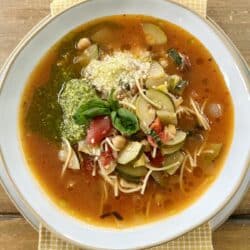

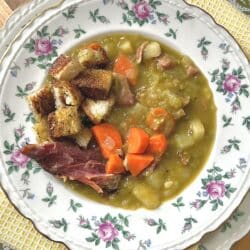
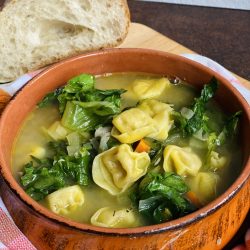
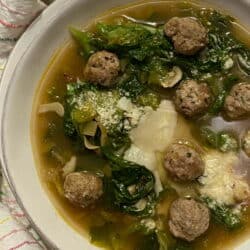
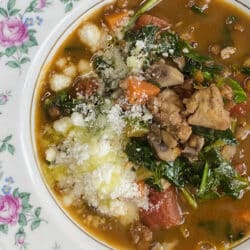

[…] a bowl of Authentic Tuscan Ribollita Soup is almost as memorable as enjoying a gelato in Italy. Almost. This Italian-inspired soup is another […]
[…] Tuscan Ribollita Soup Recipe […]
I’ve always been curious about this soup! Looking forward to your recipe.